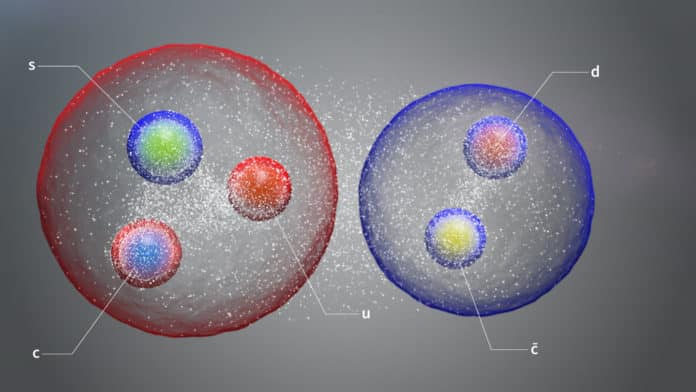Quarks are a type of elementary particle and a fundamental constituent of matter. There are six kinds of quarks with a wide range of masses: up, down, charm, strange, and top and bottom. They usually combine in two/three groups to form hadrons, such as protons and neutrons.
Recently, the international LHCb collaboration at the Large Hadron Collider (LHC) has observed three never-before-seen particles: a new kind of “pentaquark” and the first-ever pair of “tetraquarks,” which includes a new type of tetraquark.
The first kind is a pentaquark composed of an up, a down, a weird quark, and a charm quark, a charm antiquark, and observed in an analysis of “decays” of negatively charged B mesons. It is the first discovered pentaquark to have a strange quark. The result is statistically significant by a stunning 15 standard deviations, which is much higher than the five standard deviations needed to declare the detection of a particle in particle physics.
The second type is a tetraquark with two electrical charges. It is an open-charm tetraquark with an up quark, a down quark, a strange antiquark, and a charm quark. Its neutral counterpart is a collaborative examination of the decays of positively charged and neutral B mesons. It is the first time a pair of tetraquarks has been seen, and the new tetraquarks were discovered with statistical significance of 6.5 (doubly charged particle) and 8 (neutral particle) standard deviations.
LHCb physics coordinator Niels Tuning said, “The more analyses we perform, the more kinds of exotic hadrons we find. We’re witnessing a period of discovery similar to the 1950s when a ‘particle zoo’ of hadrons started being discovered and ultimately led to the quark model of conventional hadrons in the 1960s. We’re creating ‘particle zoo 2.0’.”
LHCb spokesperson Chris Parkes said, “Finding new kinds of tetraquarks and pentaquarks and measuring their properties will help theorists develop a unified model of exotic hadrons, the exact nature of which is largely unknown. It will also help to understand conventional hadrons better.”
The findings, presented today at a CERN seminar, add three new exotic members to the growing list of new hadrons found at the LHC.
